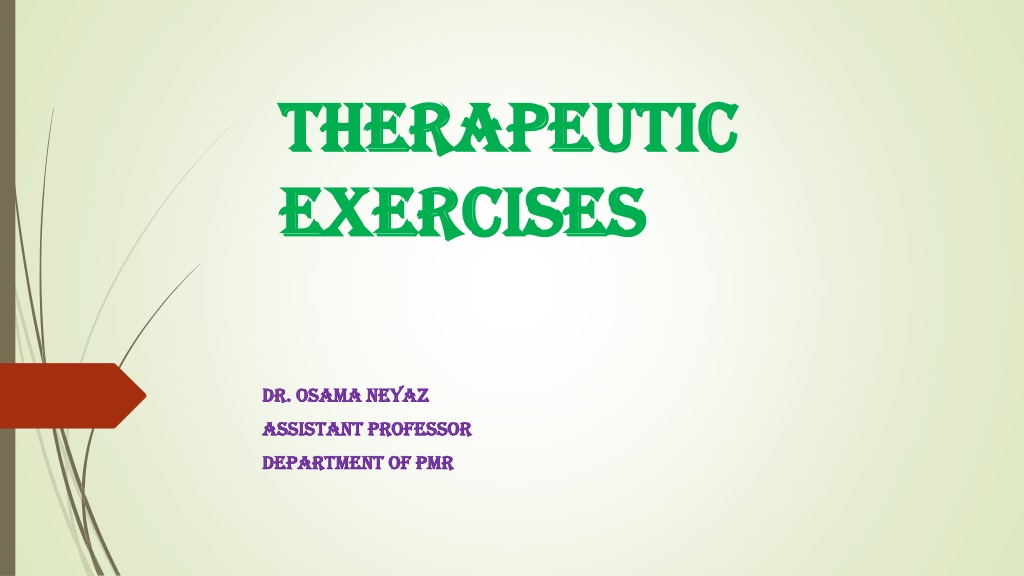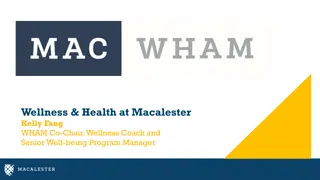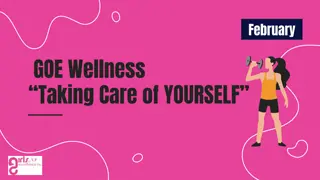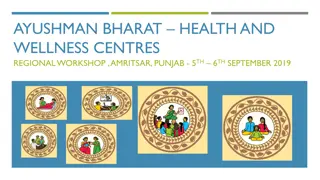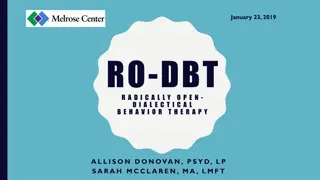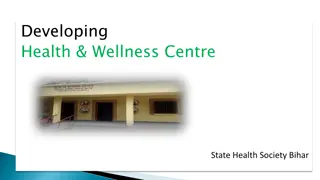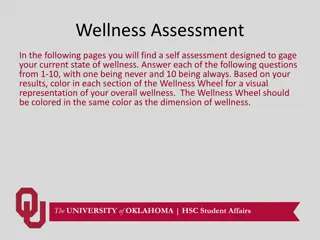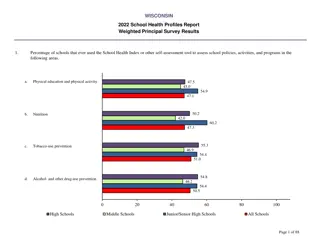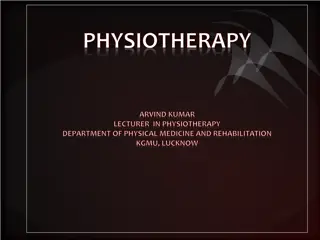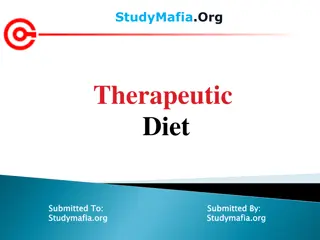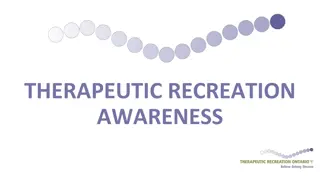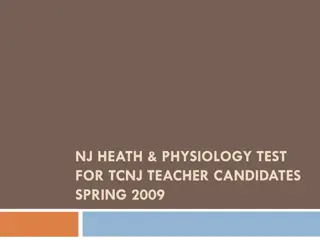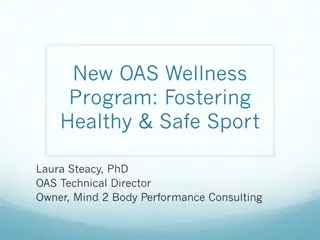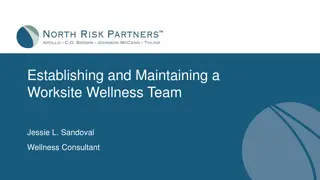Understanding Therapeutic Exercises for Health and Wellness
Therapeutic exercises, as guided by professionals like Dr. Osama Neyaz, can significantly impact physical health by targeting specific muscle groups and energy systems. This form of exercise is crucial for preventing and rehabilitating illnesses, promoting cardiovascular health, regulating blood pressure, managing weight, and improving overall well-being. By delving into the various energy systems involved in muscular contraction and the health benefits of exercise, one can gain a deeper understanding of the importance of incorporating therapeutic exercises into daily routines.
Download Presentation

Please find below an Image/Link to download the presentation.
The content on the website is provided AS IS for your information and personal use only. It may not be sold, licensed, or shared on other websites without obtaining consent from the author. Download presentation by click this link. If you encounter any issues during the download, it is possible that the publisher has removed the file from their server.
E N D
Presentation Transcript
Therapeutic Therapeutic exercises exercises Dr. Osama Neyaz Dr. Osama Neyaz Assistant Professor Assistant Professor Department of PMR Department of PMR
Overview Introduction Energy system for muscular contraction Health benefits of exercise Types of exercises Exercise prescription
Introduction Therapeutic relates to the treatment of disease/physical disorder Exercise refers to bodily exertion for the sake of training/improvement of health. Use of activities requiring physical exertion in the prevention/treatment/rehabilitation of illness and disabling conditions.
Energy Systems All three energy systems supply energy at all times but one energy system may predominate during a particular activity.
Energy Systems ATP in skeletal muscles lasts approximately 5 to 10 seconds of high-intensity work Creatine phosphate system lasts for approximately 25 seconds of high-intensity work. This provides energy for activities such as sprinting and weightlifting. Rapid Glycolysis starts along with high-intensity exercise and dominates for approximately 1.5 to 2 minutes.
Energy Systems Aerobic Oxidation System: Unlimited ability to regenerate ATP depending upon amount of fuel and oxygen available to the cell. Maximal oxygen consumption (VO2max) is a measures power of the aerobic energy system and the best indicator of aerobic fitness. Prolonged exercise ( >30 minutes) of low to moderate intensity shifts substrate utilization from carbohydrate toward fat.
Health benefits of exercise Primary and Secondary Prevention of Cardiovascular Disease Blood Pressure Regulation Weight Control Type 2 Diabetes Mellitus Prevention Improved Psychological Well-being Maintenance of Bone Density Increased Fibrinolytic Activity Decreased Inflammatory Marker Improved Endothelial Function Improved Sleep Reduced Cancer Risk
Types of exercise Cardiovascular Exercise (Aerobic exercise) Strengthening exercise Flexibility Proprioception
Pulmonary Ventilation (Ve) Volume of air exchanged per minute. At rest Approximately 6 L/min in an average sedentary adult man. At maximal exercise, increases 15- to 25-fold over resting values. Increases in Ve are directly proportional to an increase in oxygen consumption (VO2) and carbon dioxide produced (VCO2).
Anaerobic (ventilatory) threshold The anaerobic threshold signifies the peak work rate or oxygen consumption at which the energy demands exceed the circulatory ability to sustain aerobic metabolism. At critical exercise intensity Ve increases disproportionately relative to the VO2 (paralleling an abrupt increase in serum lactate and VCO2). Determined by serial measurements of blood lactate assessment of expired gases during exercise testing, specifically Ve and carbon dioxide production (VCO2).
Maximal Oxygen Consumption VO2max defined physiologically as the highest rate of oxygen transport and use, that can be achieved at maximal physical exertion. The resting oxygen consumption (250 mL/min) divided by body weight (70 kg) gives the resting energy requirement, 1 MET (approximately 3.5 mL/ kg per minute). METs is considered the best index of physical work capacity or cardiorespiratory fitness.
Symptoms of Overtraining Syndrome Sudden decline in quality of work or exercise performance Extreme fatigue Elevated resting heart rate Early onset of blood lactate accumulation Altered mood states Unexplained weight loss Insomnia Injuries related to overuse
Physical Activity Readiness Questionnaire 1. Has your doctor ever said that you have a heart condition and that you should only do physical activity recommended by a doctor? 2. Do you feel pain in your chest when you do physical activity? 3. In the past month, have you had chest pain when you were not doing physical activity? 4. Do you lose your balance because of dizziness or do you ever lose consciousness? 5. Do you have a bone or joint problem that could be made worse by a change in your physical activity? 6. Is your doctor currently prescribing drugs (e.g., water pills) for your blood pressure or heart condition? 7. Do you know of any other reason why you should not do physical activity? A yes answer to any of the questions indicates a pre-exercise evaluation before the individual begins or increases physical activity
Major Symptoms or Signs Suggestive of Cardiopulmonary Disease Pain and discomfort in the chest, neck, jaw, arms, or other areas that may be ischemic in nature Shortness of breath at rest or with mild exertion Dizziness or syncope Orthopnea or paroxysmal nocturnal dyspnea Ankle edema Palpitations or tachycardia Intermittent claudication Known heart murmur Unusual fatigue or shortness of breath with usual activities
Components of an Exercise Prescription Mode is the particular form or type of exercise. Intensity is the relative physiologic difficulty of the exercise. Intensity and duration of exercise interact and are inversely related. Duration or time is the length of an exercise session. Frequency refers to the number of exercise sessions per day and per week. Progression (overload) is the increase in activity during exercise training, which, over time, stimulates adaptation
ACSM Recommendations for Cardiorespiratory Endurance Training Mode: large muscle groups are engaged in rhythmic aerobic activity. Activities includes walking, jogging, cycling, rowing, stair climbing, aerobic dance ( aerobics ), water exercise, and cross-country skiing etc. Intensity: minimal exercise of moderate intensity (i.e., 40% to 60% of VO2max that increases HR and breathing). A combination of moderate and vigorous exercise ( 60% of VO2max results in increases in HR and breathing) is ideal for improvements in health and fitness.
Intensity Calculation Heart Rate Methods MAXIMUM HEART RATE METHOD: HRmax= 220 age (with a standard deviation of 10 beats/min) Using 70% to 85% of an individual s HRmax provides the stimulus needed to improve or maintain cardiorespiratory fitness. HEART RATE RESERVE METHOD: Rating of Perceived Exertion: The RPE is a subjective grading of how hard individuals feel they are exercising. The most commonly used scale of perceived exertion is the Borg Scale.
ACSM Recommendations for Cardiorespiratory Endurance Training Duration Physical activity may be continuous or intermittently accumulated during a day through one or more sessions of activity lasting greater than 10 minutes. The ACSM recommends physical activity for healthy adults: 1000 kcal/ week (or approximately 150 min/wk or 30 min/day). Frequency The ACSM recommends exercise 3 to 5 days per week. Less conditioned people can benefit from lower intensity, shorter duration exercise performed at higher frequency. Progression The ACSM notes a 5- to 10-minute increase every 1 to 2 weeks over the first 4 to 6 weeks.
Types of Muscle Contraction Isometric contractions are contractions in which there is no change in the length of the muscle. No joint or limb motion occurs. Isotonic contractions occur when the muscle changes length, producing limb motion. Concentric contractions occur when the muscle shortens. Eccentric contractions occur when the muscle lengthens. More fast-twitch fibers are recruited during eccentric contractions. Isokinetic contractions occur when muscle contraction is performed at a constant velocity. This can be done only with the assistance of a preset rate-limiting device.
Resistance Exercise Training program include increasing the amount of weight lifted, increasing repetitions, or increasing the velocity of training. One-repetition maximum (1-RM) is maximum amount of weight that a person can possibly lift for one repetition. Progressive resistance exercise DeLorme method: The weight for the first set is 50% of the 10-RM; the second set, 75% of the 10-RM; and the third set, 100% of the 10-RM. Regressive resistive exercise Oxford technique: an individual starts with 10 repetitions at 100% of the 10-RM, then 10 repetitions at 75% of the 10-RM, then a third set of 10 repetitions at 50% of the 10-RM.
Recommended Guidelines for Strength Training
Flexibility The total achievable excursion (within limits of pain) of a body part through its range of motion. Even small reductions in range may result in biomechanical accommodations that place abnormal stress on tissues elsewhere in the body. Benefits from stretching: I. Prevention of musculoskeletal injuries II. Improved performance in sports III. Reduced post-exercise muscle soreness IV. Improved general well-being
Factors affecting range of motion Tightness of soft-tissue structures such as muscle, tendon, ligament, and joint capsule. Involuntary muscle contraction i.e. spasm Bony contour of the joint Abnormal bone growth around a joint Intra-articular loose bodies (e.g., bone or cartilage) Excessive fluid
Stretching techniques 1) Ballistic: repetitious bouncing movements, where the momentum of a moving body segment is used to generate forces producing a rapid stretch. Greater risk for injury 2) Static: a slowly applied stretch that is held for several seconds Easy to perform Can be done voluntarily or received passively Little associated risk of injury 3) PNF (proprioceptive neuromuscular facilitation): The concept is to enhance relaxation of the muscle to be stretched through reciprocal inhibition and the stretch reflex.
Proprioception It denotes the process by which information about the position and movement of body parts is related to the central nervous system. Proprioceptive organs: including muscle (particularly intrafusal spindle fibers), skin, ligaments, and joint capsules Proprioceptive exercises used after an injury to a joint resulting in a deficit in proprioception. e.g. Tilt or wobble board training, carioca (sideways running) and backward walking or running.
